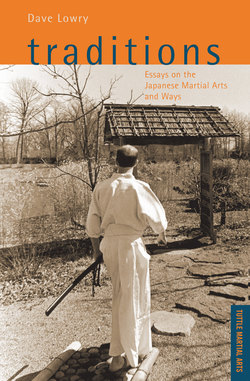Читать книгу Traditions - Dave Lowry - Страница 13
На сайте Литреса книга снята с продажи.
ОглавлениеUke-Waza (The Art of Taking It)
Anyone whose budo practice partners have included Hawaiians soon learns, as I did, the importance of “talk story.” At the university judo club where I began my judo training, some of the members were from Hawaii. Since I was still in high school, these college boys and girls were like older brothers and sisters to me, and I always felt privileged to sit in and listen to their “talk story,” a pidgin Hawaiian phrase to describe what elsewhere might be called “bull sessions.” Most evenings, after judo practice was done, we would gather on the mats and discuss everything from politics to great meals to—these being university students, after all—sex. The talk story often centered around the budo. That’s what we were discussing one night. Specifically, the topic was about the toughest individuals we had each encountered. One of the group told of another judoka he had trained with in Japan, a Japanese champion who had thrown opponents so hard that even using proper breakfalls, they were knocked unconscious by the force of hitting the mat. Another recounted the abilities of a Chinese martial artist he’d met who could employ vicious footsweeps that literally somersaulted his opponents. These stories went on and on. One fellow said the toughest people he’d ever met were Special Forces personnel in Vietnam; another insisted it was the British SAS teams.
It was Clyde Kimura, from Kauai, who spoke with a kind of final authority on the subject. The toughest individuals he had ever encountered, he said, were kendoka. “The old ones,” he said. “A kendo man who’s in his mid-sixties; been training about 50 years,” Kimura said firmly, “he can take an incredible amount of abuse.”
I have often reflected on Kimura-san’s words. Interesting, isn’t it, that his concept of toughness was not in how much one can dish out, but how much one can take?
Many of the karate masters from the old days made a great deal of the importance of uke-waza. The word is usually translated as “blocking techniques.” Actually, it means “techniques of ‘receiving.’” Recently, the senior JKA instructor in Great Britain, Keinosuke Enoeda, criticized the stagnant and limited techniques he saw in karate competition. An improvement, he advised, would be to “practice hard to acquire a profound knowledge of the unique uke-waza of karate.” Enoeda sensei’s advice will sound strange to the average karate exponent, especially to those tournament enthusiasts who are always advocating just the opposite strategy for winning karate contests. They focus their practice on more varied and dramatic strikes. But Enoeda went on to explain his reasoning. “Once you are confident in ukeru [receiving] you can anticipate any attack. It is important to attack properly with full confidence and vigor however hard you are pushed. Using this offensive ukeru, you can undermine your opponent and gain a winning chance.”
What Enoeda sensei was saying is not easy to understand. It requires some thought, and more. The karateka who wants to grasp Enoeda’s advice must be prepared to put some time in on the dojo floor, thinking about this advice with his body. “Unique uke-waza” tells us that karate’s receiving methods may be special to karate. “Offensive uke” hints that there might be something more to uke-waza than just passively anticipating an attack and then responding. True mastery of uke is the ability to deal with any kind of attack, at any stage of the attack. The adept of uke-waza has a feel for what shape his opponent’s strike will take, from what angle and so on. He can nullify it or let it come, already prepared for an appropriate counter. This approach to karate is only one half of a complete strategy. The other half is kakari-waza, or “attacking methods.” But no matter how strong one develops his kakari-waza, he must always work to polish his receiving techniques. This is a skill absolutely essential to karate competition, where one must cope with all sorts of spirited attacks.
Back in the sixties, one of the great competitors in Japanese karate was Tetsuhiko Asai, of the Japan Karate Association. One of Asai’s favorite techniques was to charge right at the front kick of an opponent. As the kicking leg extended, Asai would duck underneath, coming up behind his attacker and countering. It was a remarkable demonstration of uke-waza. (And not always successful; Asai lost an eye when he misjudged a kick once.) Asai had to be able to ascertain instantly and exactly the depth and level the kick was coming at, to “receive” it effectively. Uke-waza, performed at this level, is a different way of looking at toughness. It means being able to “take it” and to respond appropriately.
As I said, uke-waza is combined with kakari-waza, attacking techniques, to form a complete strategy. They must be balanced. It is easier to study and refine one’s attacking skills. Uke-waza takes more patience. Both, however, are necessary. Strengthening your attacks while neglecting uke-waza will result in a strategy that can be compromised or defeated when confronting an opponent who is stronger or more cunning and can get around your attack. Practice ukewaza exclusively and you will find yourself unable to initiate or to lead. You will always be responding and unnaturally passive. Learn to use and manipulate them both and you will begin to see what balance in the budo is all about . . . and the potential of its applications far beyond the confines of the training hall.
